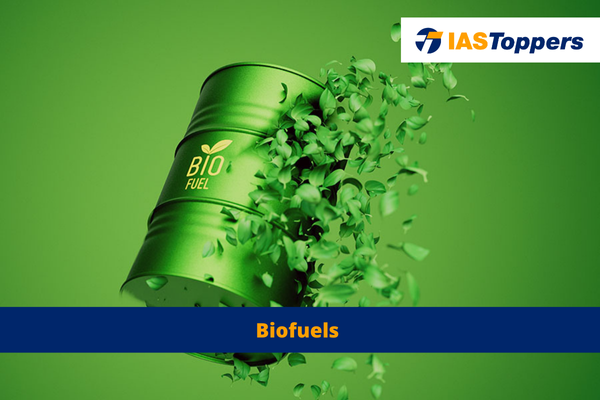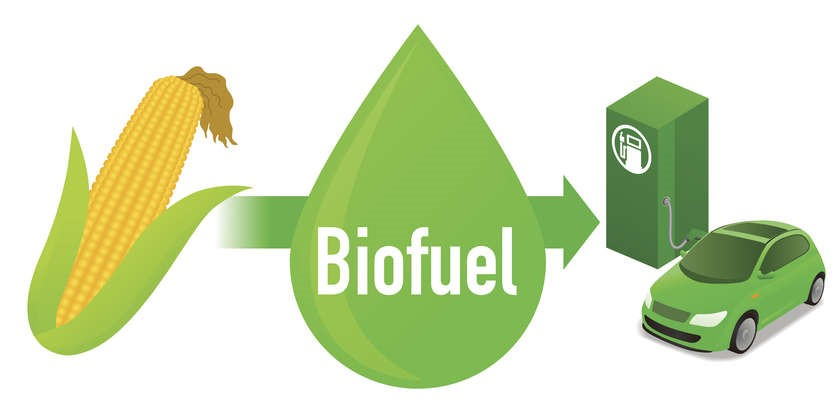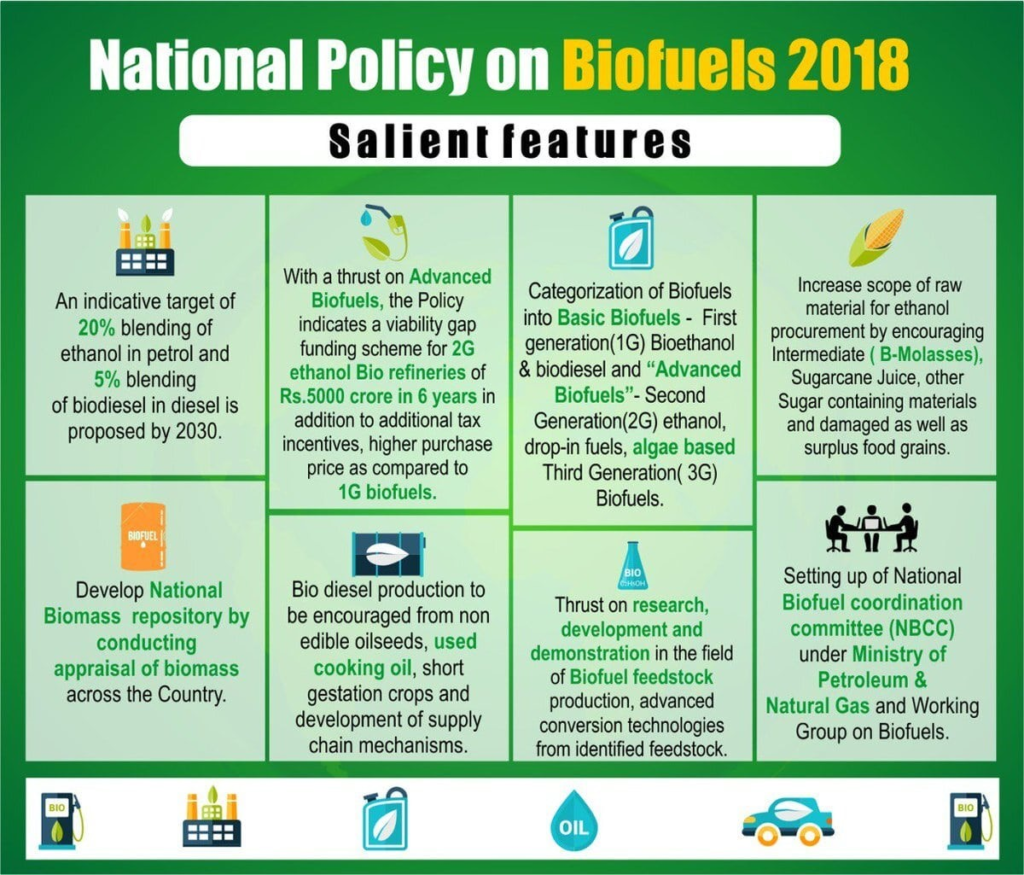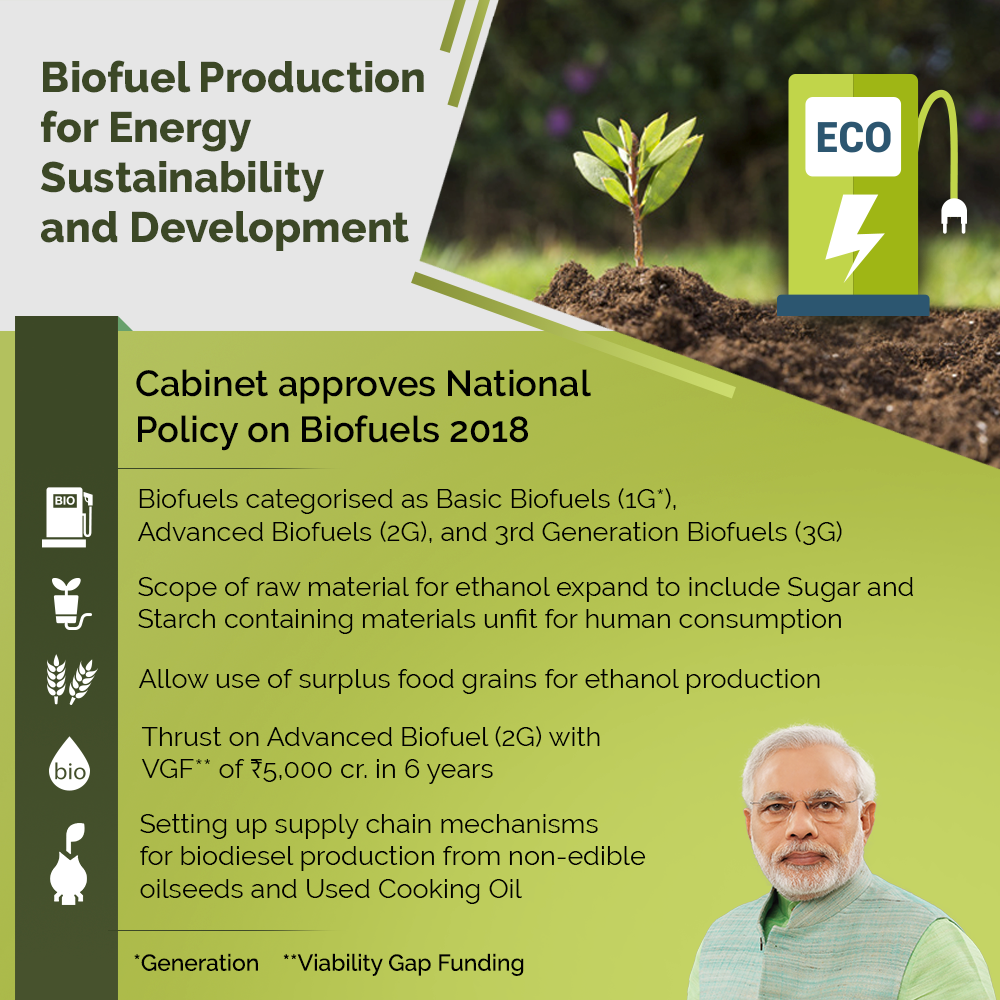Biofuel is a fuel produced in a short period of time from biomass, as opposed to the very slow natural processes involved in the formation of fossil fuels such as oil. Plants or agricultural, domestic, or industrial biowaste can be used to produce biofuel. Biofuel’s ability to mitigate climate change varies greatly, ranging from emissions comparable to fossil fuels in some scenarios to negative emissions in others.
Biofuels in India will be helpful for UPSC IAS Exam preparation. GS Paper-3 Environment.
Table of Content
- What is Biofuels?
- Types of Biofuels
- Generation of Biofuel
- Benefits of using Biofuels
- Concerns related to biofuels
- Global Biofuels Alliance
- Conclusion
- Frequently Asked Questions (FAQs)
What is Biofuels?
- Definition: Biofuels are environment-friendly fuels that can help reduce carbon emissions.
- Biofuels are derived from renewable biomass resources, which makes them a sustainable alternative to fossil fuels.
- Biofuels can help improve the economy by reducing dependence on imported crude oil and creating jobs in the agricultural sector.
- Biofuels are less toxic than diesel, which makes them a safer choice for the environment.
- The use of biofuels can reduce emissions of pollutants such as nitrogen and oxides sulfur dioxide, which can help improve air quality.
- Biofuels can help mitigate climate change by reducing greenhouse gas emissions.
Types of Biofuels
Solid Biofuels
- Solid biofuels are solid fuels that can be directly burnt to produce energy.
- They are derived from nonfossil, organic materials, including plant biomass, animal waste, and municipal waste.
- Examples include wood, grass, straw, and cow dung.
Liquid Biofuels
- Liquid biofuels are important for blending with petrol or diesel for running vehicles.
- They are derived from biomass materials called feedstocks.
- Examples include ethanol and biodiesel.
Gaseous Biofuels
- Gaseous biofuels are in a gaseous state and their components include inflammable gases like methane.
- They are produced from biomass that is used directly as a gas or converted to liquid fuels.
- An example is biogas.
Generation of Biofuel
First-generation biofuels
- 1st generation biofuels are produced from sugar, starch, and vegetable oil using conventional technology.
- They are generally made from grains high in sugar or starch fermented into bioethanol, or seeds that are pressed into vegetable oil used in biodiesel.
- Common first-generation biofuels include vegetable oils, biodiesel, bioalcohols, biogas, solid biofuels, and syngas.
Second-generation biofuels
- 2nd generation biofuels are produced from non-food crops, such as cellulosic biofuels and waste biomass (stalks of wheat and corn, and wood).
- Common second-generation biofuels include vegetable oils, biodiesel, bioalcohols, biogas, solid biofuels, and syngas.
- Research continues on second-generation biofuels including biohydrogen, bioethanol, DMF, Bio-DME, Fischer-Tropsch diesel, biohydrogen diesel, mixed alcohols, and wood diesel.
Third-generation biofuels
- 3rd generation biofuels are produced from extracting oil from algae – sometimes referred to as “oilgae”.
- Its production is supposed to be low-cost and high-yielding– giving up to nearly 30 times the energy per unit area as can be realized from current, conventional ‘first-generation’ biofuel feedstocks.
Fourth-generation biofuels
- 4th generation biofuels are produced by growing and harvesting crops that are genetically engineered to take in high amounts of carbon as biomass.
- These crops are then converted into fuel using second-generation techniques.
- Fourth-generation biofuels are a recent development in biofuel technology and are still being researched and developed.
Advantages of using Biofuels
- Renewable: Biofuels are made from renewable resources, such as plants and algae, which means they can be produced over and over again without running out.
- Clean-burning: Biofuels produce fewer emissions than fossil fuels, which can help to improve air quality.
- Sustainable: Biofuels can help to reduce our reliance on fossil fuels, which are finite resources.
- Economical: Biofuels can be a more affordable option than fossil fuels, especially in the long run.
- Efficient: Biofuels can be used in existing vehicles and machinery with little or no modification.
- Diversified: Biofuels can be made from a variety of different sources, which can help to reduce our reliance on any one crop or region.
Concerns related to biofuels
Food vs. fuel:
- The production of biofuels can create competition with food production for land, water, and other resources.
- This can lead to higher food prices and food insecurity.
Deforestation:
- The production of some biofuels, such as palm oil, can lead to deforestation.
- Deforestation can release greenhouse gases into the atmosphere and contribute to climate change.
Water use:
- The production of biofuels can require a lot of water.
- This can put a strain on water resources, especially in areas that are already water-scarce.
Pollution:
- The production and use of biofuels can release pollutants into the air and water.
- These pollutants can have negative impacts on human health and the environment.
Efficiency:
- The energy efficiency of biofuels is lower than that of fossil fuels.
- This means that more energy is required to produce biofuels than is produced by burning them.
Sustainability:
- The sustainability of biofuel production is a complex issue.
- There is no single biofuel that is universally sustainable.
- The sustainability of biofuel production depends on a variety of factors, including:
- Type of biofuel,
- Production methods, and
- Environmental and social impacts.
National Policy on Biofuels 2018
- Main goal: to reduce reliance on imports by promoting fuel blending.
- The blending program is coordinated by the National Biofuel Coordination Committee (NBCC), led by the Union Minister for Petroleum and Natural Gas.
- Initially, a blending target of 20% was set for 2030.
- Key components of the program include:
- Ethanol Blending Programme (EPB)
- Production of second-generation ethanol from the forest and agricultural residues
- Increasing production capacity for fuel additives
- Research and development in feedstock for ethanol production
- Financial incentives to achieve the program’s goals
- The government has established premium rates for ethanol derived from sugar syrup, cane juice, and B-heavy molasses.
- B heavy molasses: It is the sticky liquid formed during sugar production from cane juice.
- Sugar mills use molasses as feedstock to produce ethanol.
- The program allows the utilization of excess rice or damaged food grains as feedstock for ethanol production.
Amendments
- The important change is advancing the blending date by five years, from Ethanol Supply Year (ESY) 2030 to 2025-26.
- Other notable changes include:
- Introducing additional feedstock for biofuel production.
- Producing biofuels as part of the ‘Make in India’ program in Special Economic Zones and Export Oriented Units.
- Allowing the export of biofuels in specific cases.
- The NBCC has expanded its membership and gained the authority to modify policies, which it previously lacked.
Global Biofuels Alliance
- The Global Biofuels Alliance is an international partnership of governments and private stakeholders that aims to promote development, increase the use, and raise awareness of biofuels.
- The Alliance was created under the leadership of India and includes the following members:
- India
- United States
- Brazil
- European Union
- International Energy Agency (IEA)
- Biofuels Alliance (a group of 20 countries that wish to promote sustainable, innovative and scalable low-carbon bio-economies)
- Indian Sugar Mills Association
- Society of Indian Automobile Manufacturers
- The United States and Brazil are leaders in the production and consumption of biofuels.
- Brazil has been using 100% ethanol for running its vehicles for many years.
Conclusion
The ability of biofuel to reduce greenhouse gas emissions varies greatly, with some scenarios producing lower emissions than fossil fuels and others producing negative emissions. The International Energy Agency (IEA) predicts that biofuels will supply more than a quarter of global transportation fuel demand by 2050. However, the production and use of biofuels do not meet the IEA’s sustainable development target. Global biofuel output must increase by 10% between 2020 and 2030 to meet the IEA goal.
Ref:Source-1
FAQs (Frequently Asked Questions)
What is Algae Biofuel?
Algae fuel, algal biofuel, or algal oil is a renewable alternative to liquid fossil fuels that uses algae as its source of energy-rich oils.
What is the purpose of World Biofuel Day?
World Biofuel Day aims to promote awareness regarding the use of biofuels as a viable substitute for fossil fuels.
What are the uses of Biofuels? Or What are the applications of biofuel?
Biofuels are used as transportation fuels, but they may also be used for heating and electricity generation.
Which date in August is celebrated as World Biofuel Day?
World Biofuel Day is observed on August 10th every year to raise awareness of the importance of non-fossil fuels as a substitute for conventional fossil fuels.
What are the disadvantages of biofuels on the environment?
Disadvantages of biofuels on the environment include changes to land use patterns that may increase GHG emissions, pressure on water resources, air and water pollution, and increased food costs.
Which carbohydrates act as biofuels?
Two carbohydrates that act as biofuels are Starch and Glycogen.
What are the names of biofuel crops?
Biofuel crops are typically high in sugar (sugarcane, sugarbeet, and sweet sorghum), starch (maize and tapioca), or oils (soybean, rapeseed, coconut, and sunflower).
What are biofuel briquettes?
Briquettes made from biomass are a biofuel alternative to coal and charcoal. Briquettes are most commonly used in developing countries where cooking fuel is scarce.
What is the difference between biomass and biofuel and biogas?
The primary distinction between biomass and biogas is that biomass is a solid material, whereas biogas is a gaseous compound produced by the Anaerobic Digestion process. Biogas and biomass are two different kinds of biofuels.




